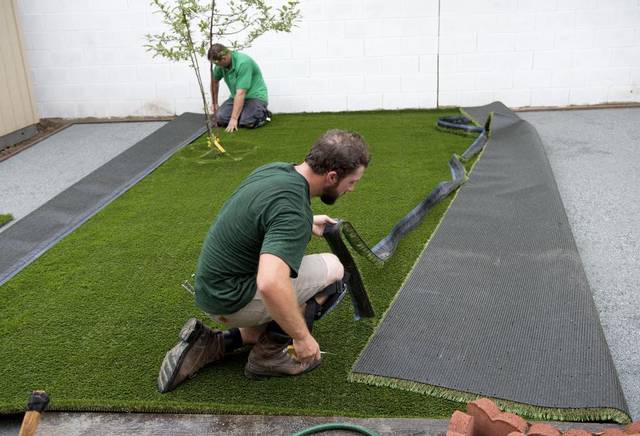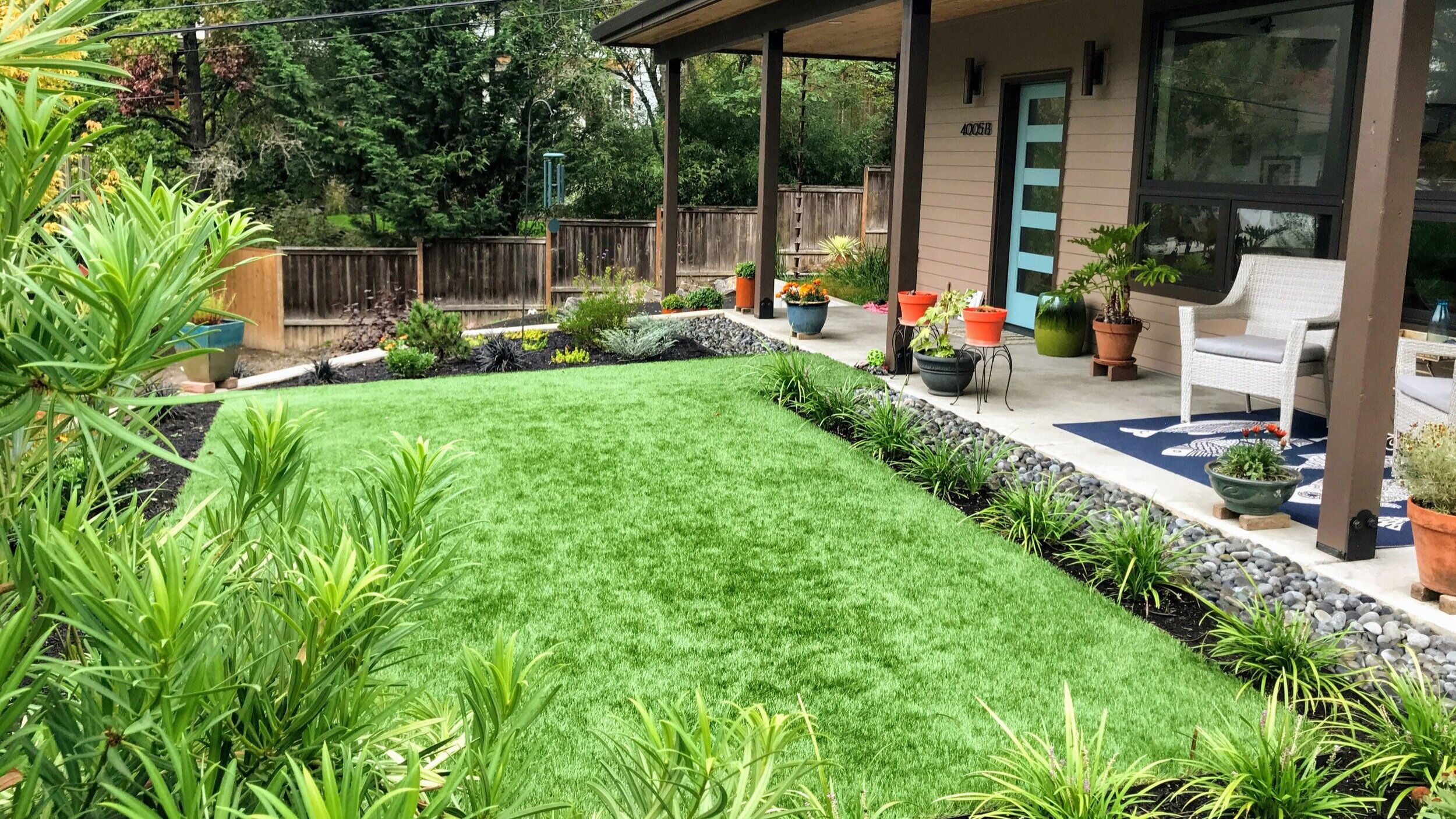Reliable Turf Installation Services in Canoga Park for Artificial Lawns
Wiki Article
Leading Reasons to Consider Artificial Turf for a Rich and Low-Maintenance Yard
As property owners significantly seek sustainable options for outdoor spaces, synthetic lawn presents an appealing choice to conventional lawns. The benefits expand beyond mere aesthetics and sustainability; discovering the diverse implications of synthetic yard reveals an extensive approach to backyard management that qualities deeper consideration.Year-Round Plant
Among the most significant benefits of man-made lawn is its capacity to offer year-round plant, regardless of climate problems. Property owners frequently face difficulties in keeping a lively yard due to seasonal changes, dry spells, or hefty rains. Man-made yard gets rid of these issues, guaranteeing a consistently lush look throughout the year.
This synthetic choice is crafted to hold up against diverse climate circumstances, from blistering summer warm to freezing winter temperatures. Unlike natural turf, which may brown or come to be patchy throughout extreme problems, synthetic lawn maintains its dynamic shade and structure, enhancing the aesthetic charm of any landscape.
Furthermore, man-made lawn is resistant to parasites and diseases that typically impact natural lawns. This strength adds to its enduring elegance, as there is no demand for chemical treatments or plant foods that can be hazardous to the environment. Additionally, property owners can appreciate the aesthetic advantages of a well-kept yard without the intermittent difficulties postured by all-natural lawn care (artificial grass installation).
Lowered Maintenance Initiatives
Fabricated grass dramatically lowers upkeep efforts, enabling homeowners to appreciate a beautiful lawn without the lengthy jobs connected with all-natural turf care. Among the most noteworthy advantages of synthetic lawn is the removal of regular mowing. Without demand for a lawnmower, property owners conserve both time and the expense of upkeep connected with this tools.

Cleaning up artificial turf is straightforward; a simple rinse with a hose pipe or the occasional cleaning to remove particles is generally sufficient - backyard artificial grass. This convenience of treatment permits house owners to spend more time appreciating their exterior spaces instead of laboring over them. In summary, the lowered maintenance initiatives related to fabricated lawn make it an appealing option for those seeking a stunning, hassle-free lawn
Water Preservation Perks
The substantial reduction in maintenance initiatives related to fabricated grass includes water preservation, making it an eco-friendly alternative for house owners. Traditional lawns need considerable quantities of water to stay lavish and vibrant, frequently leading to extreme water use, particularly in deserts. On the other hand, fabricated grass gets rid of the need for regular watering, drastically minimizing the why not find out more general water consumption in your backyard.By opting for artificial grass, house owners can conserve thousands of gallons of water every year. This shift not just benefits individual families but likewise adds to wider environmental campaigns targeted at lowering water waste. In areas experiencing water scarcity, the fostering of synthetic lawn can play a significant role in alleviating the impacts of dry spell and making sure that beneficial water resources are used extra efficiently.
Additionally, the installation of fabricated grass can assist reduced community water demand, benefiting the community in its entirety. With growing recognition of environmental issues, selecting artificial yard works as an aggressive action in the direction of sustainable landscape design, assisting to preserve natural water resources while preserving a visually pleasing outside room (artificial grass installation). In recap, artificial turf presents a compelling solution for water preservation, aligning environmental responsibility with contemporary landscape design needs

Bug and Allergy Decrease
A substantial advantage of setting up artificial turf is its ability to lower bugs and irritants in outdoor rooms. Typical turf lawns usually work as reproducing grounds for insects such as insects, ticks, and ants, which can produce pain and wellness threats for family members and animals. On the other hand, man-made turf eliminates the natural material that brings in these pests, thereby dramatically lowering their populations in your backyard.Furthermore, all-natural grass can nurture mold, pollen, and other allergens, which can activate allergies and respiratory system issues for delicate people. Synthetic turf offers a cleaner atmosphere, decreasing the capacity for allergenic responses. Unlike all-natural lawn, synthetic grass does not produce plant pollen, making it an outstanding alternative for allergy victims seeking to appreciate their outdoor areas without the threat of flare-ups.
In addition, the lack of dirt in man-made lawn means there is much less dirt and dust, additional reducing air-borne irritants. This low-maintenance alternative not just boosts the visual charm of your yard however also promotes a much healthier exterior environment, allowing families to enjoy their lawns without the constant concern of irritants and bugs. Hence, man-made turf is a strategic selection for those prioritizing comfort and wellness reference in their exterior home.
Long-Term Cost Financial Savings
Purchasing artificial lawn can bring about significant lasting price financial savings for property owners. While the preliminary investment may seem significant, the financial benefits over time can be considerable. Fabricated lawn eliminates the demand for normal lawn maintenance costs, such as mowing, fertilizing, and watering. Typical yards usually need substantial sources to keep a lush look, especially in areas prone to drought or extreme weather.Furthermore, the longevity of synthetic lawn additionally improves its cost-effectiveness. A lot of high-grade man-made yard items can last 15 to 25 years with very little upkeep, decreasing the requirement for substitute or substantial repairs. On the other hand, all-natural yard may call for regular reseeding and normal care, which can swiftly accumulate in prices.
Utility financial savings are an additional vital variable. Home owners can anticipate to see reduced water costs, as synthetic lawn does not require irrigation. Additionally, the reduction in yard care services can liberate useful time and resources, permitting home owners to assign their budgets in other places.
Conclusion
In recap, synthetic grass provides numerous advantages for homeowners seeking a low-maintenance and vibrant landscape. Ultimately, the long-term cost financial savings connected with fabricated grass solidify its status as a functional and lasting solution for boosting exterior areas.Synthetic turf significantly minimizes maintenance efforts, enabling home owners to delight in a pristine grass without the time-consuming tasks associated with natural lawn you can check here treatment.The significant decrease in upkeep initiatives connected with man-made yard prolongs to water preservation, making it an environmentally pleasant alternative for house owners. In comparison, man-made lawn gets rid of the need for normal watering, drastically lowering the overall water usage in your yard.
In locations experiencing water shortage, the adoption of artificial lawn can play a substantial duty in reducing the impacts of drought and guaranteeing that beneficial water resources are made use of extra successfully.
With growing recognition of ecological issues, choosing synthetic turf serves as a proactive step towards lasting landscape design, helping to maintain natural water sources while maintaining a cosmetically pleasing outdoor area.
Report this wiki page